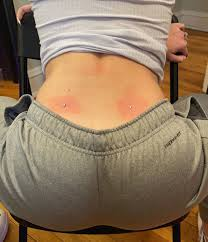Contents
- 1 Everything You Need to Know About Back Dimple Piercings
- 1.1 How is a Back Dimple Piercing Done?
- 1.2 Does It Hurt?
- 1.3 Jewelry Options for Back Dimple Piercings
- 1.4 Jewelry Materials
- 1.5 Cost of Back Dimple Piercings
- 1.6 Risks of Back Dimple Piercings
- 1.7 Healing Time for Back Dimple Piercings
- 1.8 Aftercare Instructions
- 1.9 Signs of a Problem
- 1.10 Changing the Jewelry
- 1.11 Removing the Piercing
Everything You Need to Know About Back Dimple Piercings
Back dimple piercings are a type of dermal piercing located in the indentations on your lower back, just above your buttocks. These dimples are often called the dimples of Venus, explaining why some people mistakenly refer to these as Venus piercings. However, Venus piercings, also known as Christina piercings, are actually genital piercings, so it’s helpful to understand the difference before visiting a piercing studio.
How is a Back Dimple Piercing Done?

Back dimple piercings are considered dermal piercings. The piercer will use a needle or scalpel to create a small pocket in the dermis (the middle skin layer). Then, with the help of forceps, they insert an anchor with a post into this pocket, securing the jewelry top on the post.
Here’s a breakdown of what you can expect during the appointment:
- Paperwork: You’ll need to provide ID and complete some paperwork.
- Consultation: The piercer will evaluate your back dimples to confirm you’re a suitable candidate.
- Preparation: They will clean and disinfect the area.
- Marking: Using a marker, they will pinpoint the spots for piercing.
- Piercing: The piercer will insert the jewelry into each dimple.
- Post-care: They will clean up the area and provide aftercare instructions.
Does It Hurt?
Yes, back dimple piercings can be quite painful, as the process involves piercing through several skin layers. However, pain is subjective, and everyone’s pain tolerance varies. Reports suggest a brief, intense pain, but this sensation typically subsides quickly. A skilled piercer and a relaxed mindset can make the process easier.
Jewelry Options for Back Dimple Piercings
Anchors with interchangeable tops are popular for back dermals, allowing you to switch the jewelry top without removing the anchor. Another option is diver jewelry, which has a pointed base under the skin and a decorative top. Though divers involve less bleeding, they aren’t interchangeable, which limits customization.
Jewelry Materials
High-quality, safe materials help reduce risks of allergic reactions or piercing rejection. Recommended materials include:
- Implant-grade titanium: Hypoallergenic and nickel-free, ideal for sensitive skin.
- Niobium: Hypoallergenic and corrosion-resistant.
- Implant-grade steel: Affordable and suitable for most, though may trigger reactions if you have a nickel allergy.
- 14K gold or higher: Safe if solid; avoid gold-plated options, which can flake and cause exposure to other metals.
Cost of Back Dimple Piercings
On average, back dimple piercings cost between $70 and $80 each. Jewelry may be additional, typically around $10-$20 per piece, depending on the material. Prices vary by location, studio, and the piercer’s experience. Remember, tipping (usually 20%) is a customary part of the cost for good service.
Risks of Back Dimple Piercings
These piercings face a higher risk of complications due to their location. Common risks include:
- Infection: Can result from unsterile equipment or improper aftercare.
- Displacement: If not placed deeply enough, the anchor may move.
- Rejection: May occur due to friction or if your body identifies the jewelry as a foreign object.
- Tissue damage: A poorly placed anchor can harm nerves and blood vessels.
- Tearing: Clothing or movements can snag the piercing, potentially tearing the skin.
Healing Time for Back Dimple Piercings
Typically, back dermals take 1 to 3 months to heal, though some may require up to 6 months. Healing depends on factors like the piercer’s skill, your overall health, and how well you follow aftercare instructions. It’s normal to experience some crusting and swelling for the first week or two, which should gradually improve.
Aftercare Instructions
Proper aftercare is essential for successful healing and to prevent buildup under the jewelry top. Key aftercare steps include:
- DO: Wash hands before touching, clean with saline, pat dry with a clean paper towel, shower instead of taking baths, wear loose clothing, and sleep on your side.
- DON’T: Touch with unclean hands, use harsh products like alcohol, use beauty products near the piercing, engage in activities causing pressure, allow saliva or other bodily fluids to touch the area, or wear tight clothing that rubs against it.
Signs of a Problem
Mild swelling and crusting are normal, but other symptoms may signal an issue. See a healthcare provider if you experience symptoms like severe pain, hot skin, foul odor, or pus-like discharge. Signs of rejection include displacement, drooping jewelry, or a widened hole.
Changing the Jewelry
Avoid changing jewelry until your piercing has fully healed, as this could lead to irritation or infection. It’s best to have a professional change your jewelry to avoid dislodging the anchor.
Removing the Piercing
If you want to retire your piercings, have your piercer safely remove them. Once removed, each hole will close and leave a small scar that fades over time, though it may not disappear completely.
Ready to Get Pierced? If you’re set on getting back dimple piercings, finding a reputable, experienced piercer is crucial. Start by researching local studios that meet health and safety standards. A visit to the studio beforehand can help ensure you feel comfortable and confident in their services.








